
NCERT Solutions for Class 8 Maths Chapter 13: Chapter 13 of the NCERT Solutions for Class 8 Maths Students need to be introduced to graphs to enhance their logical and mental skills. Experts in the field have created exercise-by-exercise answers for every question, following the most recent CBSE Class 8 syllabus. Students can use the Class 8 Mathematics NCERT Solutions for the years to help with assignments and test preparation.
NCERT Class 7 Math These solutions are provided so that students can rehearse solving them regularly and improve their exam scores. The study of mathematics involves a great number of intricate formulas and theorems. It might be difficult and draining to figure out the solutions to the questions on the board exams. Despite this, a student who is driven and skilled in the topic would be able to pass the examinations and get good grades with ease.NCERT Solutions for Class 8 Maths Chapter 13 Overview
In schools, graphs are taught as part of the maths curriculum. Students find it easier to explain facts and to organize and analyze information logically when they use charts. Students of all levels can study the data and conclude mathematical relationships with ease and visibility thanks to line graphs. Introduction to Graphs is covered in Chapter 13 of the maths curriculum for Class 8. This is a crucial chapter that is included in the syllabus. All the information needed to solve and practice the sums in this chapter is contained in the NCERT Solutions for Class 8 Maths Chapter 13. This chapter is divided into four main sections.NCERT Solutions for Class 8 Maths Chapter 13 PDF
Here we have provided NCERT Solutions for Class 8 Maths Chapter 13 for the ease of students so that they can just download the pdf and use it easily without the internet. These NCERT Solutions for Class 8 Maths Chapter 13 will help students understand the chapter better.NCERT Solutions for Class 8 Maths Chapter 13 PDF
NCERT Solutions for Class 8 Maths Chapter 13
Here we have provided NCERT Solutions for Class 8 Maths Chapter 13 for the ease of students so that they can prepare better for their upcoming exams -1. The following graph shows the temperature of a patient in a hospital, recorded every hour.
(a) What was the patient’s temperature at 1 p.m.?
(b) When was the patient’s temperature 38.5° C?

(c) The patient’s temperature was the same two times during the period given. What were these two times?
(d) What was the temperature at 1.30 p.m.? How did you arrive at your answer?
(e) During which periods did the patient’s temperature show an upward trend?
Solution:
(a) The patient’s temperature was 36.5 o C at 1 p.m. (b) The patient’s temperature was 38.5 o C at noon. (c) The patient’s temperature was the same at 1 p.m. and 2 p.m. (d) The temperature at 1.30 p.m. is 36.5 o C. The point between 1 p.m. and 2 p.m., the x-axis is equidistant from the two points showing 1 p.m. and 2 p.m. So, it represents 1.30 p.m. Similarly, the point on the y-axis, between 36 0 C and 37 0 C, represents 36.5 0 C. (e) The patient’s temperature showed an upward trend from 9 a.m. to 11 a.m. and from 2 p.m. to 3 p.m.2. The following line graph shows the yearly sales figures for a manufacturing company.

(a) What were the sales in (i) 2002 and (ii) 2006?
(b) What were the sales in (i) 2003 and (ii) 2005?
(c) Compute the difference between the sales in 2002 and 2006.
(d) In which year was there the greatest difference between the sales as compared to the previous year?
Solution:
(a) The sales in (i) 2002 was Rs. 4 crores and (ii) 2006 was Rs. 8 crores (b) The sales in (i) 2003 was Rs. 7 crores and (ii) 2005 was Rs. 10 crores. (c) The difference of sales in 2002 and 2006 = Rs. 8 crores–Rs. 4 crores= Rs. 4 crores (d) In the year 2005, there was the greatest difference between the sales, and compared to its previous year, which is (Rs. 10 crores –Rs. 6 crores) = Rs. 4 crores3. For an experiment in Botany, two different plants, plant A and plant B, were grown under similar laboratory conditions. Their heights were measured at the end of each week for 3 weeks. The results are shown in the following graph.

(a) How high was Plant A after (i) 2 weeks and (ii) 3 weeks?
(b) How high was Plant B after (i) 2 weeks and (ii) 3 weeks?
(c) How much did Plant A grow during the 3 rd week?
(d) How much did Plant B grow from the end of the 2nd week to the end of the 3 rd week?
(e) During which week did Plant A grow most?
(f) During which week did Plant B grow the least?
(g) Were the two plants of the same height during any week shown here? Specify.
Solution:
(a) (i) Plant A was 7 cm high after 2 weeks. (ii) After 3 weeks, it was 9 cm high. (b) (i) Plant B was also 7 cm high after 2 weeks. (ii) After 3 weeks, it was 10 cm high. (c) Plant A grew=9 cm–7 cm = 2 cm during 3 rd week (d) Plant B grew from end of the 2 nd week to the end of the 3 rd week = 10cm–7cm= 3cm (e) Plant A grew the highest during the second week. (f) Plant B grew the least during the first week. (g) Yes. At the end of the second week, plants A and B were of the same height, which is 7 cm.4. The following graph shows the temperature forecast and the actual temperature for each day of the week.
(a) On which days was the forecast temperature the same as the actual temperature?
(b) What was the maximum forecast temperature during the week?
(c) What was the minimum actual temperature during the week?
(d) On which day did the actual temperature differ the most from the forecast temperature?

Solution:
(a) On Tuesday, Friday, and Sunday, the forecast temperature was the same as the actual temperature. (b) The maximum forecast temperature was 35 o C. (c) The minimum actual temperature was 15 o C. (d) The actual temperature differed the most from the forecast temperature on Thursday.5. Use the tables below to draw linear graphs
(a) The number of days a hillside city received snow in different years.

(b) Population (in thousands) of men and women in a village in different years.

Solution:
(a) Consider “Years” along the x-axis and “Days” along the y-axis. Using the given information, the linear graph will look like this: (b) Consider “Years” along the x-axis and “No. of Men and No. of Women” along the y-axis (2 graphs). Using the given information, the linear graph will look like this:
(b) Consider “Years” along the x-axis and “No. of Men and No. of Women” along the y-axis (2 graphs). Using the given information, the linear graph will look like this:

6. A courier person cycles from a town to a neighboring suburban area to deliver a parcel to a merchant. His distance from the town at different times is shown in the following graph.
(a) What is the scale taken for the time axis?
(b) How much time did the person take for the travel?
(c) How far is the place of the merchant from the town?
(d) Did the person stop on his way? Explain.
(e) During which period did he ride fastest?

Solution:
(a) 4 units = 1 hour (b) The person took 3 ½ hours for the travel. (c) It was 22 km far from the town. (d) Yes, this has been indicated by the horizontal part of the graph. He stayed from 10 a.m. to 10.30 a.m. (e) He rides the fastest between 8 a.m. and 9 a.m.7. Can there be a time-temperature graph as follows? Justify your answer.

Solution:
(i) It is a time-temperature graph. It shows the increase in temperature as time increases. (ii) It is a time-temperature graph. It shows the decrease in temperature as time increases. (iii) The graph figure (iii) is not possible since the temperature is increasing very rapidly, which is not possible. (iv) It is a time-temperature graph. It is showing constant temperature.NCERT Solutions for Class 8 Maths Chapter 13 Ex 13.2
1. Plot the following points on a graph sheet. Verify if they lie on a line
(a) A(4,0), B(4, 2),C(4,6), D(4, 2.5)
(b) P(1, 1), Q(2, 2), R(3,3), S(4, 4)
(c) K(2, 3), L(5, 3), M(5,5), N(2, 5)
Solution:
Plot all the points on the graph. (a) All points, A, B, C, and D, lie on a vertical line.
(b) P, Q, R, and S points also make a line. It verifies that these points lie on a line.
(c) Points K, L, M and N. These points do not lie in a straight line.
(a) All points, A, B, C, and D, lie on a vertical line.
(b) P, Q, R, and S points also make a line. It verifies that these points lie on a line.
(c) Points K, L, M and N. These points do not lie in a straight line.
2. Draw the line passing through (2,3)and(3,2). Find the coordinates of the points at which this line meets the x-axis and y-axis.
Solution:
Graph for the line passes through points (2, 3) and (3, 2) is The coordinates of the points at which this line meets the x-axis at (5, 0) and Y axis at (0,5).
The coordinates of the points at which this line meets the x-axis at (5, 0) and Y axis at (0,5).
3. Write the coordinates of the vertices of each of these adjoining figures.

Solution:
We can observe three figures named, OABC, PQRS, and LMK.Vertices of Figure OABC
O (0, 0), A (2, 0), B (2, 3) and C (0, 3)Vertices of figure PQRS
P (4, 3), Q (6, 1), R (6, 5), and S (4, 7)Vertices of figure LMK
L (7, 7), M(10, 8) and K(10,5)4. State whether True or False. Correct those that are False.
(i) A point whose x-coordinate is zero and y-coordinate is non-zero will lie on the y-axis.
(ii) A point whose y-coordinate is zero and x-coordinate is 5 will lie on the y-axis.
(iii) The coordinates of the origin are (0, 0).
Solution:
i) True. ii) False; it will lie on the x-axis. (iii) True.NCERT Solutions for Class 8 Maths Chapter 13 Ex 13.3
1. Draw the graphs for the following tables of values, with suitable scales on the axes.(a) Cost of apples.

(b) Distance traveled by car.

(i) How much distance did the car cover during the period 7.30 a.m. to 8 a.m.?
(ii) What was the time when the car had covered a distance of 100 km since its start?
(c) Interest on deposits for a year.

(i) Does the graph pass through the origin?
(ii) Use the graph to find the interest on Rs 2500 for a year.
(iii) To get an interest of Rs. 280 per year, how much money should be deposited?
Solution:
Mark “number of apples” on the x-axis and “cost” on the y-axis. The graph is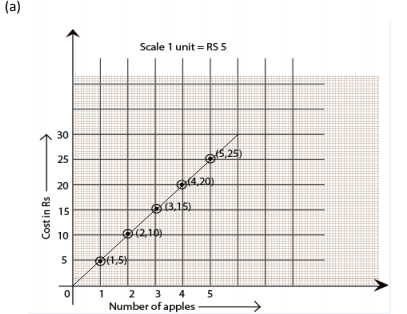 (b) Represent the “time” on the x-axis and “distance” on the y-axis.
(b) Represent the “time” on the x-axis and “distance” on the y-axis.
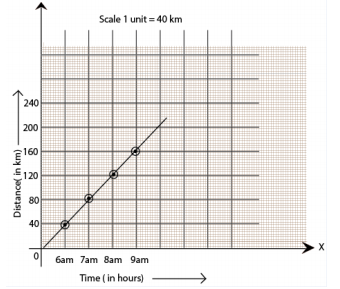 (i) The car covered a distance of 20 km.
(ii) It was 7.30 am when it covered a distance of 100 km.
(c) Represent “Deposit” on the y-axis and “simple interest” on the x-axis.
(i) The car covered a distance of 20 km.
(ii) It was 7.30 am when it covered a distance of 100 km.
(c) Represent “Deposit” on the y-axis and “simple interest” on the x-axis.
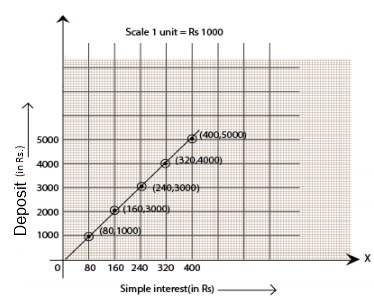 (i) Yes, the graph passes through the origin.
(ii) Interest on Rs. 2500 is Rs. 200 for a year.
(iii) Rs. 3500 should be deposited for the interest of Rs. 280.
(i) Yes, the graph passes through the origin.
(ii) Interest on Rs. 2500 is Rs. 200 for a year.
(iii) Rs. 3500 should be deposited for the interest of Rs. 280.
2. Draw a graph for the following.
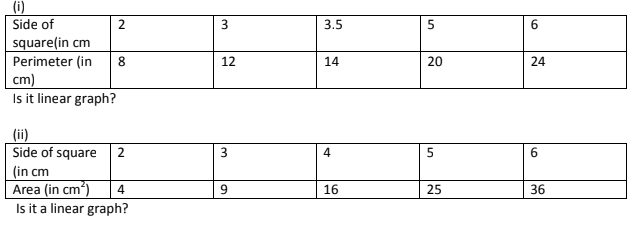
Solution:
(i) Yes, it is a linear graph.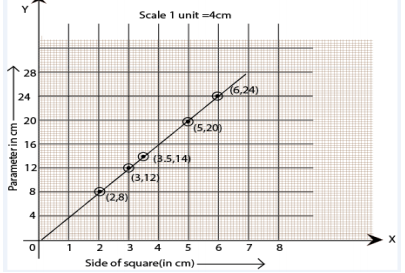 (ii) No, it is not a linear graph because the graph does not provide a straight line.
(ii) No, it is not a linear graph because the graph does not provide a straight line.
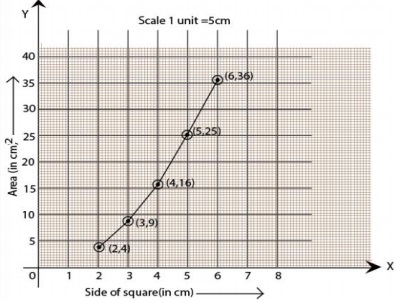
Benefits of NCERT Solutions for Class 8 Maths Chapter 13
NCERT Solutions for Class 8 Maths Chapter 13, which covers Introduction to Graphs, offers several benefits to students:Concept Clarity : NCERT Solutions provides step-by-step explanations and solutions to problems, helping students understand the fundamental concepts of graphs clearly.
Structured Learning : The solutions follow the NCERT textbook structure, ensuring that students cover all essential topics and learn systematically.
Practice and Application : By solving the NCERT exercises with the help of solutions, students get ample practice in graph-related problems. This practice enhances their problem-solving skills and prepares them for exams.
Exam Preparation : Since NCERT textbooks are the basis for most school exams, using NCERT Solutions ensures that students are well-prepared for their class tests and examinations.
Visual Representation : Graphs are visual representations of data and relationships. NCERT Solutions often include diagrams and graphs where necessary, aiding visual learners in better understanding the concepts.
Self-assessment : Students can use NCERT Solutions to self-assess their understanding of the chapter. They can check their answers against the provided solutions and identify areas where they need more practice or clarification.
Consolidation of Learning : By revisiting and practicing through NCERT Solutions, students consolidate their learning of graph-related concepts, making it easier to apply these skills to more complex problems later on.
Accessibility : NCERT Solutions are widely available online and in print, making them easily accessible for all students regardless of their location.
NCERT Solutions for Class 8 Maths Chapter 13 FAQs
Which is the most easiest chapter in class 8 maths?
What is the introduction of graph in maths?
Is 8th class difficult?









